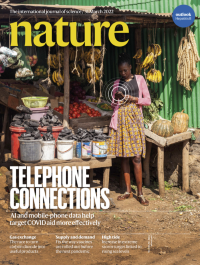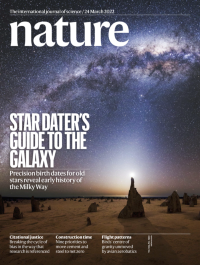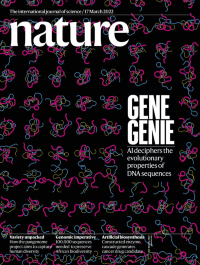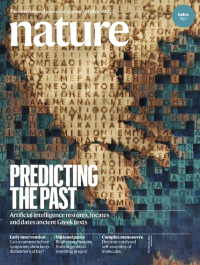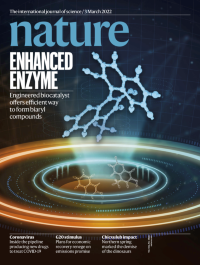Volume 603
-
No. 7903 31 March 2022
Telephone connectionsThe cover shows Yournina Akinyi using her mobile phone at her produce stand in Matasia village, Kenya. In this week’s issue, Joshua Blumenstock and his colleagues show how big data derived from mobile phone networks can improve the targeting of humanitarian aid. Rapid identification of those in greatest need is a significant challenge during a crisis. Blumenstock and his team used conventional survey data to train machine-learning algorithms to recognize patterns of poverty in mobile phone data. Their method was then used in Togo to distribute millions of dollars in COVID-19 relief. The researchers found that compared with more conventional targeting methods, their machine-learning approach reduced the proportion of individuals in need who missed out on aid by 4–21%, suggesting that data sources such as phones could enhance aid distribution in times of crisis.
Nature Outlook
-
No. 7902 24 March 2022
Star dater’s guide to the GalaxyThe cover image shows a view of the Milky Way captured at Nambung National Park in Western Australia. To understand how the Galaxy formed requires precision age dating of the stars that it contains. In this week’s issue, Maosheng Xiang and Hans-Walter Rix of the Max Planck Institute for Astronomy in Heidelberg, Germany, present an analysis of the birth dates for nearly 250,000 stars in their subgiant evolutionary phase, when they can serve as precise stellar clocks. The researchers found that the individual ages of the stars ranged from about 1.5 billion to more than 13 billion years old. Tripling the age-dating precision for such a large stellar sample allowed the researchers to infer the sequence of events that initiated our Galaxy’s formation. Using this information, Xiang and Rix were able to determine that the oldest part of our Galaxy’s disk had already begun to form about 13 billion years ago, just 800 million years after the Big Bang, and that the formation of the inner Galactic halo was completed some 2 billion years later.
Spotlight
-
No. 7901 17 March 2022
Gene genieFor more than 50 years, scientists have been trying to understand the relationship between DNA sequence, gene-expression phenotype and fitness to decipher principles of gene regulatory evolution. In this week’s issue, Eeshit Dhaval Vaishnav, Carl de Boer, Aviv Regev and their colleagues present a framework for understanding and engineering regulatory DNA sequences that takes a step towards this goal. The researchers built this framework around an ‘oracle’ they developed using a deep neural network model that predicts gene expression given a promoter DNA sequence. The neural network was trained using the expression measurements for tens of millions of promoter sequences. The result was an AI oracle that predicts expression from sequence well enough to study the evolutionary history and future evolvability of regulatory DNA sequences, as well as to design regulatory DNA sequences for synthetic biology applications. The cover offers a visual representation of the evolutionary properties of sequences at the extremes of the evolvability spectrum.
-
No. 7900 10 March 2022
Predicting the pastInscriptions provide an invaluable insight into the ancient world. But over the centuries, many inscriptions have been damaged and exist in fragmented or semi-legible forms, making the job of reading and interpreting them extremely difficult. In this week’s issue, Yannis Assael, Thea Sommerschield and their team introduce Ithaca, a deep neural network designed to help historians restore and understand ancient Greek inscriptions. Working alone, Ithaca is able to restore damaged texts with a 62% accuracy, but when historians use Ithaca, their accuracy on the same task rises to 72%. Ithaca can also determine the original geographical location of inscriptions with 71% accuracy, and can date them to within 30 years from the date ranges proposed by historians. The researchers say that such cooperation between artificial intelligence and historians could help transform studies of the ancient world.
Nature Index
-
No. 7899 3 March 2022
Enhanced enzymeBiaryl compounds, which contain two connected aromatic rings, are common throughout chemistry, medicine and materials science. Joining together the individual molecular components to form these compounds can be a challenge. In this week’s issue, Alison Narayan and her colleagues report the design and engineering of enzyme biocatalysts that help to connect the necessary building blocks through their carbon–hydrogen bonds. The researchers used engineered forms of cytochrome P450 enzymes as the catalyst, and as a result were able to transform a low-yielding, unselective reaction into one that efficiently joined phenols to form biaryl compounds with control over both which C–H bonds are coupled and the stereochemistry of the products.
Nature Outline

